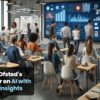
Team meetings can be a daunting thing as a new leader either to a senior or middle leader role. If you’re new to the senior leadership team you may be worrying about; how you’ll fit in, how and when to speak up, if your Head will respond positively to interjections, how senior team meetings are run within your school. Any Head worth their salt will probably have mentioned to you in your new role about how meetings will take place as part of your induction into the team. Running a meeting effectively is something that comes with practice however there are some key things you can do to prepare yourself for this sometimes overlooked aspect of a leaders role.
Not everyone runs meetings the same way but here are some things that I do when I’m the person charged with running / organising meetings.
Before the meeting
As you’ll remember from attending meetings yourself, there will be an agenda. It will be your responsibility to create this. Normally the items on the agenda will be forthcoming quite easily. There will be things that are approaching on the calendar that you’ll need to discuss, discussions around tracking of pupils and their work, so forth and so on. Some items on the agenda will be informational and will just involve passing the information on to colleagues to make them aware of the information. This could be anything from reminders about parent / teacher consultation evenings to other school events, coursework deadlines, so forth and so on. Often, many of the items on an agenda won’t actually need discussing at all. Either way, you will still need to create an agenda.
Creating an agenda is a relatively easy thing to do. Some hallmarks exist on most agenda however and it is good practice to make sure that you include them on the document. Make sure you include:
- Agenda title, e.g. My School Department Agenda
- Meeting start time
- Meeting end time (not everyone includes an end time but I recommend it)
- Meeting location
- Expected attendees (often by initials)
- Agenda items (write next to each agenda item what time duration you’d like to spend on each item – this will help keep the meeting to time.)
On agendas
I always create my agenda using collaborative documents with my team. If you are a Google, Microsoft or Apple-centric school it doesn’t really matter. You can use Google Docs, Microsoft Word or Pages to create a collaborative agenda. Just write it and then share it with your team via their connected school accounts.
By creating your agenda as a collaborative and shared document you will always have a live document and as you’ll see from later on in this post, you’ll easily be able to generate your minutes (the record of the meeting) from the previously created agenda.
If you have informational points on your agenda, save your meeting time by including the information straight onto the document. This will save time on your meeting. There have been many times when I’ve been preparing for a meeting and the agenda has contained mostly informational items, this has meant I have been able to chair meetings really quickly saving me and my team valuable time. There is no point in making your team sit and listen to you explaining something that they could just read. They are professionals, right? Treat them as such. Ask if there are any questions around these items, but hopefully as they are informational they should be quick to cover.
Another benefit of using collaborative documents such as Google Docs, it is very easy to link related documents you have stored on your Google Drive accounts in your school / department ensuring ease of access for the team. It’s also really simple to hyperlink to other sources / resources you might need to share.
I have always advocated team members adding their thoughts to the collaborative document before the meeting too. This gives the team plenty of time to give their thoughts to agenda items prior to the meeting. This again can make for a more slick and quick meeting which sometimes can lead to a point where the team don’t need to meet for very long at all.
Allow for team members to add agenda items too although depending upon your team dynamics, you may want to have a general rule that team members to run the agenda item idea by you before putting it onto the document.
One final key point is to make sure that you share the agenda with your team in a timely fashion. If you want a successful meeting it’s important to give your team the opportunity to read any related materials or prepare things that they might need to bring to the meeting.
During the meeting
It is convention to agree the minutes from previous meetings at the start of a meeting. You may wish to do this or not. Either way though it is an important thing to check before you end the meeting that the team agrees with the record of the meeting you have just had.
I’ve always tried to utilise my team with a variety of roles in my team meetings. Having a timekeeper, someone to take the minutes (although we can all work on the document at the same time) and rotating these roles, including the chair, can be a great way to build a shared sense of responsibility in an effective meeting. I strongly see it is an effective CPD opportunity for members of your team to chair meetings and take on other roles too. Keeping a meeting a) on track and b) on time is a difficult task to master at first. It’ll help your meetings run more smoothly although don’t expect that to happen straight away!

A key aspect of the minute taking is to ensure that key actions are recorded. Information such as what the actions are, who is responsible and by when is really important. Reviewing key actions at the end of the meeting and just repeating who is responsible for completing these and by when is an important light-touch reinforcement.
After the meeting
At the end of the meeting a good thing to do is to ask your team how effective they thought the meeting was. An agenda item you should include on every agenda too is AOB – Any Other Business. Another standing item on my meetings is to ask the team how they thought the meeting went. This peer review each and every meeting is an effective but simple way to ensure that you show what went well and what could be improved. Remember to revisit those key actions, who does it and by when too!
Something I like to add if time allows onto faculty meetings too is for each team member to share something great that has happened in their classrooms that week. It could be a great piece of work. It could be a student who has turned things around. It could be a new edtech tool they’ve used with their pupils that has had a great effect. Sharing positive things that have been happening in the classrooms of your faculty or department is a great way of sharing and celebrating good practice.
If a member of your team cannot attend for any reason then the collaborative document also serves as a brilliant reference point for the key discussions and actions on each of the different agenda points. It also saves you the job of having to print and distribute the minutes to your team members. Additionally, as you’ll want to share the completed minutes with your line manager or to your PA for filing, again, easy sharing of the document direct from the browser makes it an easy action to complete.
On ‘AOB’
Make it clear to your team that if they want to include an item on the agenda for AOB that it is added to the agenda in a timely fashion. There will be times where you will need to be flexible about last-minute AOB items, but making it a general rule that they cannot be added last minute will ensure that timekeeping is kept to time. We all have lives outside of work that we want to get home to if we having our meetings after school and if we are meeting during the school day, a timely end to a meeting is important as all team members will have other commitments that we will need to get to. That lunch duty isn’t going to happen by itself!
On pecuniary interests
There may be occasions where items that will be discussed on the agenda might have conflicting or ‘pecuniary’ interests for some of the people attending the meeting. An example of this was when I was a staff governor. I was on the staffing committee. There were times where my job was being discussed and my performance management related to progression and pay rises and so quite rightly at the beginning of the meeting I made my interests in this section of the meeting known. At that point in the meeting I left so that the remaining members of the committee could have that discussion without any bias being added by my obvious interest in the outcome of that conversation and decision making. When that part of the meeting was over I was invited back into the meeting by the chair and we continued the meeting. Thankfully the decisions always went in my favour. Rightly though, I had no influence on the decision being made by my presence and I was not able to vote on the decision either.
To sum up
- Don’t do it all yourself
- Share the chair
- Record key actions – who, when, where
- Let collaborative tools do a lot of the leg work
- Publish agenda in a timely fashion
- Rotate roles in the team
- Be mindful of pecuniary interests of people in your meeting














